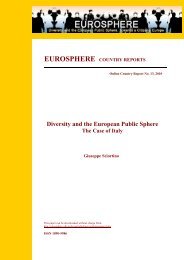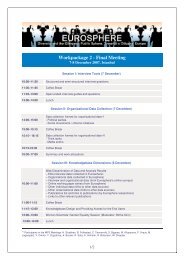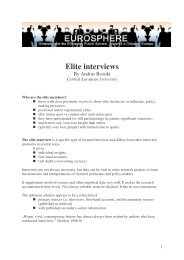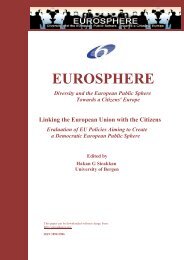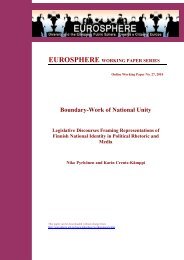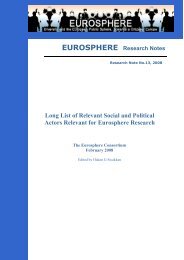Migrants, Minorities, Belongings and Citizenship. Glocalization and ...
Migrants, Minorities, Belongings and Citizenship. Glocalization and ...
Migrants, Minorities, Belongings and Citizenship. Glocalization and ...
You also want an ePaper? Increase the reach of your titles
YUMPU automatically turns print PDFs into web optimized ePapers that Google loves.
territories. This is an alignment between national territorial belongings <strong>and</strong> the “European<br />
territorial” belonging.<br />
As Figure 5 illustrates, the respondents with high degrees of European-territorial<br />
belonging are those who belong to majority populations, historical-native minorities,<br />
imperial new minorities, <strong>and</strong> second country nationals. Regarding imperial new<br />
minorities, their European-territorial identification can be understood on the background<br />
of the inclusion policies that came as a consequence of their residence countries’<br />
European integration (e.g. Russians in Estonia). Third country nationals <strong>and</strong> co-ethnics<br />
(extra-territorials) residing in the six countries have a low degree of European-territorial<br />
identification. Concerning extra-territorials, the issue is that the European citizenship<br />
structure excludes them from European citizenship <strong>and</strong> does not explicitly support their<br />
residence countries’ favorable treatment of them. Concerning third country nationals, the<br />
majority of them have a high degree of mobility of mind concerning their territorial<br />
belongings. On the other h<strong>and</strong>, those who state to have a territorial identity refer<br />
simultaneously to the cities they resided in before migration <strong>and</strong> the cities of their<br />
present residence – rather than countries of residence or birth.<br />
Figure 5. European-Territorial Belonging by Respondents’ Category<br />
0,60<br />
0,40<br />
0,20<br />
0,00<br />
-0,20<br />
-0,40<br />
-0,60<br />
Majority Historical<br />
Native<br />
Imperial<br />
new<br />
minority<br />
Imperial<br />
historical<br />
minority<br />
Category<br />
Second<br />
Country<br />
Third<br />
Country<br />
Extraterritorial<br />
Without going into further details at this stage, the result from this data set is that<br />
European belonging relates differently to other belongings in different modes of multiple<br />
belongings. The three dimensions (3, 4 <strong>and</strong> 5 in Table 6), where European <strong>and</strong> national<br />
belongings relate positively to each other, explain together 35,67% of the total variance.<br />
The two dimensions (1 <strong>and</strong> 2) where the European <strong>and</strong> national identities relate<br />
73



